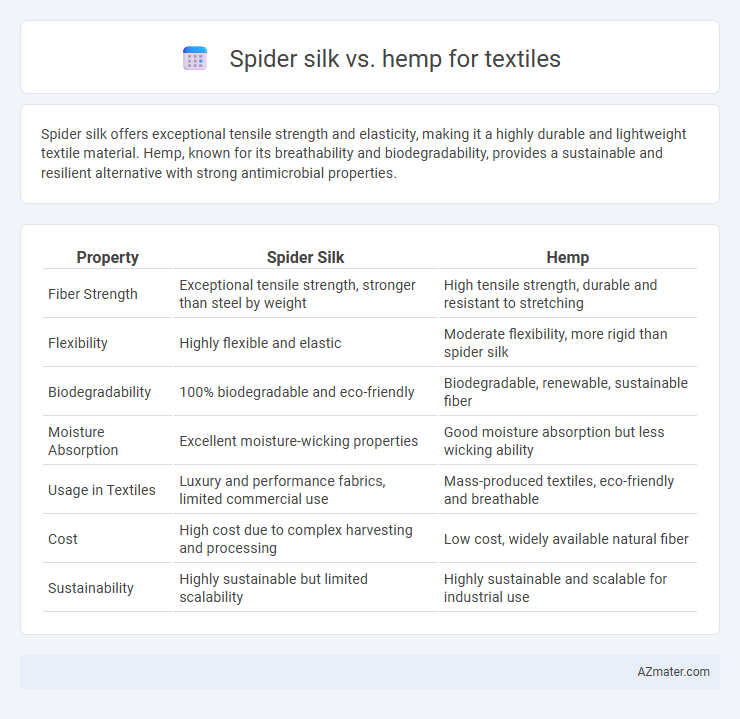Spider silk offers exceptional tensile strength and elasticity, making it a highly durable and lightweight textile material. Hemp, known for its breathability and biodegradability, provides a sustainable and resilient alternative with strong antimicrobial properties.
Table of Comparison
| Property | Spider Silk | Hemp |
|---|---|---|
| Fiber Strength | Exceptional tensile strength, stronger than steel by weight | High tensile strength, durable and resistant to stretching |
| Flexibility | Highly flexible and elastic | Moderate flexibility, more rigid than spider silk |
| Biodegradability | 100% biodegradable and eco-friendly | Biodegradable, renewable, sustainable fiber |
| Moisture Absorption | Excellent moisture-wicking properties | Good moisture absorption but less wicking ability |
| Usage in Textiles | Luxury and performance fabrics, limited commercial use | Mass-produced textiles, eco-friendly and breathable |
| Cost | High cost due to complex harvesting and processing | Low cost, widely available natural fiber |
| Sustainability | Highly sustainable but limited scalability | Highly sustainable and scalable for industrial use |
Introduction: Spider Silk and Hemp in Textile Innovation
Spider silk, renowned for its exceptional tensile strength and elasticity, offers unmatched durability and lightweight properties in textile innovation, making it a superior alternative to many natural fibers. Hemp, valued for its sustainability, breathability, and resistance to UV light and mold, provides eco-friendly advantages and robustness suitable for diverse textile applications. Both fibers represent cutting-edge advancements in materials science, driving the future of sustainable and high-performance textiles.
Historical Overview of Spider Silk and Hemp Usage
Spider silk has been admired since ancient times for its exceptional strength and elasticity, with early civilizations such as the Greeks and Chinese experimenting with its use in textiles and medical applications. Hemp fibers have a long history dating back thousands of years, prominently utilized in ancient civilizations like Egypt and Mesopotamia for durable fabric, ropes, and sails. Both materials demonstrate a rich legacy in textile production, with hemp dominating mass use due to easier cultivation, while spider silk remained rare and prized for its superior mechanical properties.
Sustainable Sourcing: Environmental Impact Comparison
Spider silk offers superior sustainability compared to hemp, as it is biodegradable, requires minimal water, and emits fewer greenhouse gases during production. Hemp cultivation benefits from rapid growth and natural pest resistance, reducing the need for chemical fertilizers and pesticides, promoting soil health through crop rotation. While both fibers contribute to eco-friendly textiles, spider silk's low environmental footprint and biodegradable properties make it an increasingly preferred choice for sustainable sourcing in the textile industry.
Mechanical Properties: Strength, Durability, and Flexibility
Spider silk exhibits exceptional tensile strength, surpassing steel by weight, making it highly durable and resistant to stretching or breaking under stress. Hemp fibers offer remarkable tensile strength and durability, though generally lower than spider silk, with excellent resistance to abrasion and environmental wear. Flexibility in spider silk is superior, allowing significant elongation without damage, whereas hemp fibers are stiffer but maintain enough flexibility for diverse textile applications.
Production Challenges: Scalability and Cost Factors
Spider silk production faces significant scalability challenges due to the complexity of farming spiders and extracting silk, resulting in high costs and limited output. Hemp, by contrast, benefits from established large-scale agricultural practices, making fiber production more cost-effective and scalable. The cost disparity between spider silk and hemp fibers largely arises from the labor-intensive extraction process and low yield of spider silk compared to the abundant and renewable nature of hemp fibers.
Versatility in Textile Applications
Spider silk offers exceptional versatility in textile applications due to its remarkable strength, elasticity, and lightweight nature, making it ideal for high-performance fabrics and advanced wearable technology. Hemp provides robust durability, breathability, and natural antimicrobial properties, excelling in sustainable and eco-friendly textile production for everyday clothing and industrial uses. Combining spider silk's superior mechanical properties with hemp's environmental advantages creates innovative textiles that balance performance and sustainability.
Comfort and Wearability: Texture, Breathability, and Allergenicity
Spider silk offers unmatched softness and a smooth texture that enhances comfort, significantly outperforming hemp, which has a coarse and rough feel. The breathability of spider silk is superior due to its fine fiber diameter, promoting excellent moisture-wicking and temperature regulation compared to hemp's thicker, denser weave. Spider silk is hypoallergenic and less likely to cause skin irritation, whereas hemp fibers can sometimes trigger allergic reactions or discomfort for sensitive individuals.
Biodegradability and End-of-Life Considerations
Spider silk exhibits superior biodegradability compared to hemp, breaking down naturally without releasing harmful residues. Hemp fibers, while biodegradable, tend to decompose slower due to their lignin content, which can impact soil quality over time. End-of-life considerations favor spider silk for its potential in producing eco-friendly textiles with minimal environmental footprint.
Emerging Technologies: Synthetic Spider Silk and Hemp Blends
Emerging technologies in textile manufacturing are advancing the development of synthetic spider silk and hemp blends, combining the strength and elasticity of spider silk with the durability and sustainability of hemp fibers. Companies like Spiber and Bolt Threads utilize bioengineered proteins to produce synthetic spider silk at scale, which when blended with hemp, create fabrics that offer enhanced tensile strength, biodegradability, and moisture-wicking properties. These innovative textiles are gaining traction in performance apparel and eco-friendly fashion, providing a sustainable alternative to traditional synthetic fibers.
Future Prospects: Market Trends and Industry Adoption
Spider silk's exceptional strength, biodegradability, and elasticity position it as a revolutionary material for sustainable textile innovation, attracting significant investment in bioengineering and synthetic production methods. Hemp offers robust eco-friendly properties, rapid growth cycles, and minimal pesticide needs, making it a favored choice for expanding organic and durable textile markets. Emerging consumer demand for sustainable fabrics drives increased industry adoption of both spider silk and hemp, with projections indicating substantial growth fueled by environmental regulations and circular economy principles.

Infographic: Spider silk vs Hemp for Textile
 azmater.com
azmater.com